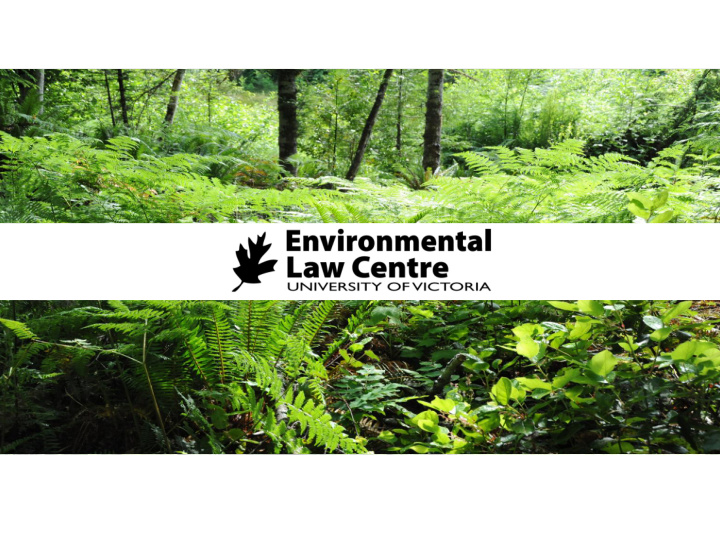



Presentation to Special Committee on Cosmetic Pesticides Professor Chris Tollefson Hakai Chair in Environmental Law & Sustainability Executive Director, UVic Environmental Law Centre Faculty of Law, University of Victoria
Key Points Who we are: our perspective and mandate Legal Context: Spraytech v Town of Hudson (SCC, 2001) The Precautionary Principle & taking regulatory precaution seriously The ELC’s model bill
The Environmental Law Centre ELC: a non profit society that operates, in partnership with the UVic Faculty of Law, Canada’s first public interest environmental law clinic Give students hands-on advocacy experience in public interest environmental law Provide advice & representation to NGOs, community & environmental groups, and First Nations Advocate for thoughtful, pragmatic & scientifically sound environmental law reform Promote access to justice for clients & causes that might otherwise go unrepresented Today: speak for ELC; drawing on Feb 2010 Discussion Paper prepared for our clients Canadian Cancer Society (BC & Yukon) & Toxics Free Canada
The Legal Context Spraytech v. Hudson [2001: SCC] a test case brought to challenge authority of local gov’ts (creatures of provincial law) to regulate cosmetic pesticides Outcome? bylaw consistent with enabling provision; and not inoperative due to alleged inconsistency with federal or provincial laws the subsidiary principle: regulation often best pursued at level closest to citizens affected bearing in mind need for multi-level action the precautionary principle (discuss later)
Post- Spraytech developments Dramatic expansion in provincial and local govt initiatives around cosmetic pesticides issue At local level, 150 ordinances & bylaws across Canada; 28 in BC (as of 2010) Dow Chemicals case under Chapter 11 of the NAFTA in connection with Quebec ban of 2,4D: filed in 2009; abandoned without costs in spring 2011
The Precautionary Principle: its Rise to Prominence Rio Declaration on Environment & Development (1992) Principle 15 Turns maxim ‘better safe than sorry’ into a regulatory obligation in the face of uncertainty P-15 is a relatively permissive version: … where there are threats of serious or irreversible damage, lack of full scientific certainty shall not be used as a reason for postponing cost-effective measures to prevent environmental degradation…
Precautionary Principle: Current Status & Implications Growing incorporation into environmental laws worldwide (including SARA, CEPA, CEAA etc) Interpretive doctrine: Spraytech Arguably a customary principle of int’l law; and an emerging ‘domestic’ common law principle In its modest guise: 1) reverses burden of uncertainty where significant potential risks; and 2) compels regulators to respond proportionally to risk, and in way that adapts response as more knowledge comes to light
Incorporating a precautionary approach into environmental regulation Rethinking who bears burden of uncertainty Proportional regulatory responses based on magnitude of the risk, and assessment of costs/benefits Adaptive learning (harvesting knowledge from and developing solutions for diverse communities) Balancing subsidiarity with need for a cooperative, multi-level approach Transparency Facilitating regulatory transition
The ELC’s Model Law: I Scope & Application : cosmetic = non-essential use of any non- white-listed pesticide additive features include regulation of sales & use on non-municipal/residential property Continued exceptions for agriculture, forestry & health and safety uses regulated through permitting regime; some limited transitional provisions no pre- emption of local gov’t bylaws Proportionality & subsidiarity
The ELC’s Model Law: II Listed Products : adopt a ‘white - list’ approach that identifies low risk pesticides; akin to that used in Ontario & Quebec complements federal regulation of manufacture, distribution & use revisiting burden of uncertainty; transparency
The ELC’s Model Law: III Enforcement : employ point of sale (as opposed to use ban) approach combined with reporting and recording requirements; align with public education efforts ( subsidiarity/complementarity; proportionality ) Public Education: training for vendors/dispensers/applicators/users ( proportionality; adaptive learning ) Public Accountability: impose data gathering & reporting duties across the board ( transparency; adaptive learning; proportionality )
References ELC, “Submissions on Restricting Cosmetic Pesticide Use in British Columbia” (February 2010) available at www.elc.uvic.ca C. Tollefson and J. Thornback, “Litigating the Precautionary Principle in Domestic Courts” (2008) 19 Journal of Environmental Law and Practice 33-58 available http://law.uvic.ca/faculty_staff/faculty_directory/tollefson.php#section0-11
Recommend
More recommend